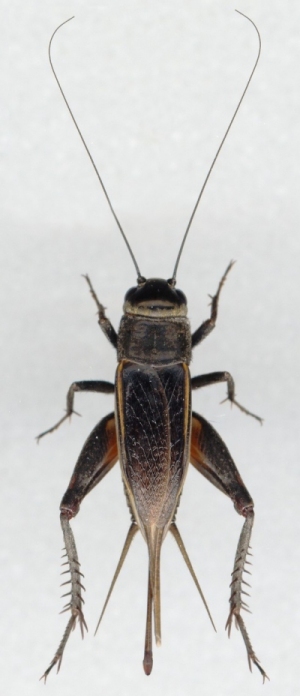Field Crickets
 Scientific Name
Scientific Name
Gryllus sp.
Distribution and Hosts
Various species of field crickets occur over most of the United States and all of Oklahoma. We believe there are five species in eastern Oklahoma and at least two of these occur in the western part of the state. Field crickets will feed on almost anything. They occasionally damage cultivated crops such as alfalfa, cotton, and strawberries. They can also damage vegetables and ornamentals when they are numerous.
Damage
The major importance is as a nuisance pest when they come to lights in homes and urban areas during periods of high abundance. Their chirping or mere presence is a nuisance to some. Also, they will sometimes damage fabrics, especially if soiled, and may chew on wood, plastic, rubber, or leather goods. The most serious outbreak in recent years occurred in 1953 when large numbers of crickets invaded cities and towns in many parts of Oklahoma and surrounding states. One report stated, "During warm nights, the streets beneath bright lights were black with crickets, sides of buildings were completely covered with tremendous numbers of the pests, and some streets were hazardous for driving due to the slipperiness caused by the crushed crickets."
Life Cycle
The eggs are usually laid in the soil. The newly hatched nymphs burrow to the surface. They will molt 8 to 10 times over a period of 2 to 3 months before becoming adults. One species overwinters as nymphs and the adults are present in the spring and early summer. Others overwinter as eggs and adults are present during the summer and fall. In certain years, field crickets appear in very large numbers during August and September. These outbreaks seem to occur after periods of prolonged dry weather in the spring and early summer followed by rainfall in July and August. Extensive soil cracking may be an important factor. Good sites for egg deposition, an abundance of favorable food, vegetation for shelter, and a scarcity of parasites and predators may also be involved.
Description
Field crickets are black or dark brown insects about 1 inch long as adults. They have large hind legs (for jumping) and most have well-developed wings. Nymphs are similar but are smaller and lack wings. Both have long, slender antennae.
Control
Crickets commonly spend the daylight hours hiding in dark, damp areas. The elimination of piles of bricks, stones, wood, or other debris around the home will help reduce numbers. Weeds and dense vegetation around the foundations of homes are other good hiding places. Nearby trash dumps, which provide both food and shelter, should be cleaned out. Since crickets are attracted to lights, the elimination of light sources at night will reduce the numbers attracted to the home area. Measures such as caulking, weather stripping, and making sure all screens and doors are tight fitting will help reduce the numbers that can enter your home or business. Adult crickets can be difficult to control. Inside homes or buildings, ready-to-use sprays or aerosols applied to baseboards, door thresholds, and cracks and crevices where crickets hide will normally control them. Also, it is frequently helpful to spray outside around the foundation, in ornamental beds, the patio, the area surrounding stacked firewood, etc. The outside treatment will help prevent crickets from moving into a building. Please contact your local county extension office for current information.
